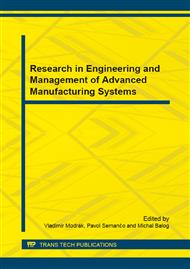p.22
p.28
p.34
p.38
p.44
p.50
p.56
p.65
p.71
Risk Assessment Using the AHP Method in the Automotive Industry
Abstract:
Modern cars consist of approximately thirty thousand parts and components; their assembly in an assembly plant is preceded by the supply via an optimally functioning supply chain. Ramification of this chain depends on a car model and equipment; however, the number of direct and indirect suppliers often reaches approximately one hundred and more. That is why perfect mutual cooperation among these suppliers is required while applying the logistic, managerial, as well as information methods to increase the efficiency and eliminate the production down-time. Over the past years, number of events forced major car manufacturers to reassess the supply chain flexibility in high-risk situations.The main objective of this study is to identify weak, high-risk sides of the supply chain and assess them applying the AHP method which represents an efficient tool of multiple-criteria decision making.
Info:
Periodical:
Pages:
44-49
Citation:
Online since:
December 2014
Authors:
Keywords:
Price:
Сopyright:
© 2015 Trans Tech Publications Ltd. All Rights Reserved
Share:
Citation:


